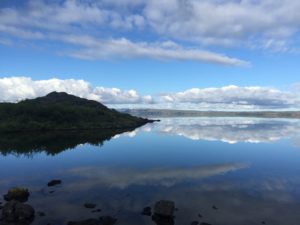

We planned to one person stay at depth of the “Big Crack”, another person holding the measuring tape, and then another person using the measuring tape. We would measure the width of the crack and then also use a buoy to mark every 20 meters. We practiced a couple times on how everything would play out in the water.
The water at Davidsgja was about 6-8 deg.C. A nice warm up from Silfra. The visibility was about 15 meters. I think the visibility at the bottom of the crack (approximately 160 meters from our starting point) was about 20-30 meters. Very Beautiful.
We had a couple of hiccups during the task. For one, the diveshop didn’t have a measuring tape, so we had created our own from a line and some electrical tape. This made measuring easy to spot the 1 meter tags, but difficult when trying to reel the line back in. Consequently, it took us longer to measure out 20 meter increments. We also had to split the task into two separate dives because of the length of the task.
You really need to have good teamwork, great underwater communications skills, patience, and preparation for the project to be successful. I was really fortunate that the other DMTs were great to work with. Cheers to another task complete!
Lessons Learned
Preparation: Get a satellite image of the dive site. Draft the entry and exit points.
Rehearsal: Practice what each person is going to do in the water on the surface. Practice the hand signals you will show to each other to note what you need and what to do next. Go over this at least three times until it’s drilled into each person’s head on what they are going to do.
Equipment check: Make sure all equipment is secured. Pencils, slates, cameras, measuring tape, etc. Double check everyone has everything.
Note taking: Take pictures of your slate before you erase anything. Record video of significant site logs and time on your computer as well as your slate notes to keep track of everything.
Click here if you want more information on my entire divemaster experience at dive.is
